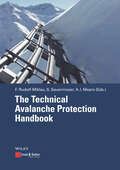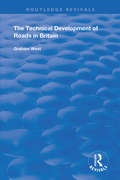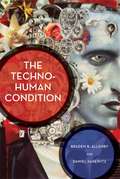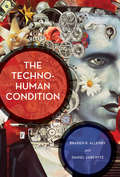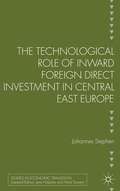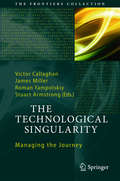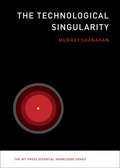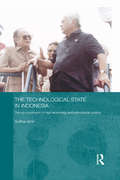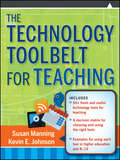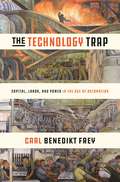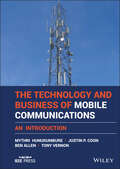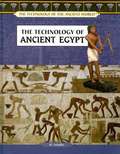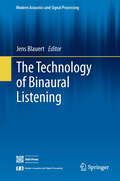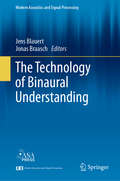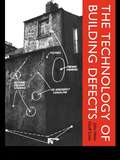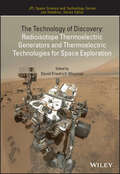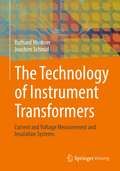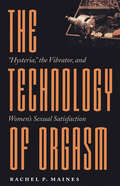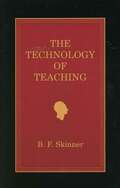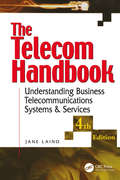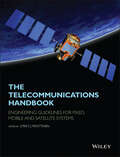- Table View
- List View
The Technical Avalanche Protection Handbook
by Florian Rudolf-Miklau Monica Boensch Arthur Mears Siegfried SauermoserSnow avalanches can have highly destructive consequences in developed areas. Each year, avalanche catastrophes occur in mountain regions around the globe and cause unnecessary fatalities and severe damage to buildings and infrastructure. In some mountainous regions, especially in the European Alps, technical avalanche defence structures are built to increase the level of safety for inhabited areas; however, new infrastructure such as roads, railway lines and tourist facilities cause new risk potential in hazardous areas. As a result, the demand is increasing for technical avalanche protection solutions. Avalanche defence structures and protection systems are used in most inhabited mountain regions worldwide. During the last decades, technical avalanche protection has evolved from a specialist field to an independent engineering branch that has gained importance in alpine countries such as Austria, Italy, France and Switzerland, as well as in other countries such as Canada, Iceland, Norway and USA. This work is the first comprehensive, English-language overview of technical avalanche protection and establishes state-of-the-art best practices in the field. It covers the fundamentals of avalanche protection technology and includes plans, dimensions, construction and maintenance of defence structures. The editors have collaborated with an international team of experts from Austria, Canada, France, Iceland, Italy, Japan, Norway, Switzerland and USA to produce this landmark handbook.
The Technical Development of Roads in Britain (Routledge Revivals)
by Graham WestThis title was first published in 2003. The history of roads in Great Britain has not been one of steady development, but rather, one that has waxed and waned in response to social, military and economic needs, and also as to whether there have been alternative methods of transport available. Paralleling this, the technical aspects of road construction - with the one great exception of Roman roads - can be seen as a fitful progression of improvement followed by neglect as the roadmaker has responded, albeit tardily on occasion, to the needs of the road user. This text describes the technical development of British roads in relation to the needs of the time, and thereby touches upon its relation to the history of the country more generally.
The Techno-Human Condition
by Daniel Sarewitz Braden R. AllenbyIn this latest version of humanity, we are equipped with a fully re-engineered immune system; the latest set of cultural assumptions about gender, ethnicity, and sexuality; and a suite of customized enhancements, including artificial joints, neurochemical mood modulators, and performance-boosting hormones. In The Techno-Human Condition, Braden Allenby and Daniel Sarewitz explore what it means to be human in an era of incomprehensible technological complexity and change. They argue that if we are to have any prospect of managing that complexity, we will need to escape the shackles of current assumptions about rationality, progress, and certainty, even as we maintain a commitment to fundamental human values. Humans have been co-evolving with their technologies since the dawn of prehistory, when tool making and meat eating co-evolved with brain development and social complexity. What is different now is that we have moved beyond external technological interventions to transform ourselves from the inside out--even as we also remake the Earth system itself. Coping with this new reality, say Allenby and Sarewitz, means liberating ourselves from such categories as "human," "technological," and "natural" to embrace a new techno-human relationship. Describing the- terms of this relationship, and exploring sociotechnical systems ranging from railroads to modern military technology, Allenby and Sarewitz ultimately locate individual authenticity in the quest for a new humility in the face of the rapidly disappearing moorings of the Enlightenment.
The Techno-Human Condition
by Daniel Sarewitz Braden R. AllenbyA provocative analysis of what it means to be human in an era of incomprehensible technological complexity and change.In The Techno-Human Condition, Braden Allenby and Daniel Sarewitz explore what it means to be human in an era of incomprehensible technological complexity and change. They argue that if we are to have any prospect of managing that complexity, we will need to escape the shackles of current assumptions about rationality, progress, and certainty, even as we maintain a commitment to fundamental human values.Humans have been co-evolving with their technologies since the dawn of prehistory. What is different now is that we have moved beyond external technological interventions to transform ourselves from the inside out—even as we also remake the Earth system itself. Coping with this new reality, say Allenby and Sarewitz, means liberating ourselves from such categories as “human,” “technological,” and “natural” to embrace a new techno-human relationship. ContributorsBoris Barbour, Mario Biagioli, Paul S. Brookes, Finn Brunton, Alex Csiszar, Alessandro Delfanti, Emmanuel Didier, Sarah de Rijcke, Daniele Fanelli, Yves Gingras, James R. Griesemer, Catherine Guaspare, Marie-Andrée Jacob, Barbara M. Kehm, Cyril Labbé, Jennifer Lin, Alexandra Lippman, Burkhard Morganstern, Ivan Oransky, Michael Power, Sergio Sismondo, Brandon Stell, Tereza Stöckelová, Elizabeth Wager, Paul Wouters
The Technological Indian
by Ross BassettIn the late 1800s India seemed to be left behind by the Industrial Revolution. Today there are many technological Indians around the world but relatively few focus on India's problems. Ross Bassett--drawing on a database of every Indian to graduate from the Massachusetts Institute of Technology through 2000--explains the role of MIT in this outcome.
The Technological Role of Inward Foreign Direct Investment in Central East Europe
by Johannes StephanForeign direct investment (FDI) assumed a prominent role in Central East Europe (CEE) early on in the transition process. Foreign investors were assigned the task of restructuring markets, providing capital and knowledge for investment in technologically outdated and financially ailing firms.
The Technological Singularity
by James Miller Victor Callaghan Roman Yampolskiy Stuart ArmstrongThis volume contains a selection of authoritative essays exploring the central questions raised by the conjectured technological singularity. In informed yet jargon-free contributions written by active research scientists, philosophers and sociologists, it goes beyond philosophical discussion to provide a detailed account of the risks that the singularity poses to human society and, perhaps most usefully, the possible actions that society and technologists can take to manage the journey to any singularity in a way that ensures a positive rather than a negative impact on society. The discussions provide perspectives that cover technological, political and business issues. The aim is to bring clarity and rigor to the debate in a way that will inform and stimulate both experts and interested general readers.
The Technological Singularity
by Murray ShanahanThe idea that human history is approaching a "singularity" -- that ordinary humans will someday be overtaken by artificially intelligent machines or cognitively enhanced biological intelligence, or both -- has moved from the realm of science fiction to serious debate. Some singularity theorists predict that if the field of artificial intelligence (AI) continues to develop at its current dizzying rate, the singularity could come about in the middle of the present century. Murray Shanahan offers an introduction to the idea of the singularity and considers the ramifications of such a potentially seismic event. Shanahan's aim is not to make predictions but rather to investigate a range of scenarios. Whether we believe that singularity is near or far, likely or impossible, apocalypse or utopia, the very idea raises crucial philosophical and pragmatic questions, forcing us to think seriously about what we want as a species. Shanahan describes technological advances in AI, both biologically inspired and engineered from scratch. Once human-level AI -- theoretically possible, but difficult to accomplish -- has been achieved, he explains, the transition to superintelligent AI could be very rapid. Shanahan considers what the existence of superintelligent machines could mean for such matters as personhood, responsibility, rights, and identity. Some superhuman AI agents might be created to benefit humankind; some might go rogue. (Is Siri the template, or HAL?) The singularity presents both an existential threat to humanity and an existential opportunity for humanity to transcend its limitations. Shanahan makes it clear that we need to imagine both possibilities if we want to bring about the better outcome.
The Technological Society
by Jacques EllulAs insightful and wise today as it was when originally published in 1954, Jacques Ellul's The Technological Society has become a classic in its field, laying the groundwork for all other studies of technology and society that have followed. Ellul offers a penetrating analysis of our technological civilization, showing how technology—which began innocuously enough as a servant of humankind—threatens to overthrow humanity itself in its ongoing creation of an environment that meets its own ends. No conversation about the dangers of technology and its unavoidable effects on society can begin without a careful reading of this book. "A magnificent book . . . He goes through one human activity after another and shows how it has been technicized, rendered efficient, and diminished in the process.&”—Harper's &“One of the most important books of the second half of the twentieth-century. In it, Jacques Ellul convincingly demonstrates that technology, which we continue to conceptualize as the servant of man, will overthrow everything that prevents the internal logic of its development, including humanity itself—unless we take necessary steps to move human society out of the environment that 'technique' is creating to meet its own needs.&”—The Nation &“A description of the way in which technology has become completely autonomous and is in the process of taking over the traditional values of every society without exception, subverting and suppressing these values to produce at last a monolithic world culture in which all non-technological difference and variety are mere appearance.&”—Los Angeles Free Press
The Technological State in Indonesia: The Co-constitution of High Technology and Authoritarian Politics (Routledge Contemporary Southeast Asia Series)
by Sulfikar AmirUsing a historical sociology approach, this book illustrates the formation of the technological state in Indonesia during the New Order period (1966-1998). It explores the nexus between power, high technology, development, and authoritarianism situated in the Southeast Asian context. The book discusses how the New Order regime shifted from the developmental state to the technological state, which was characterized by desire for technological supremacy. The process resulted in the establishment of a host of technological institutions and the undertaking of large-scale high-tech programs. Shedding light on the political dimension of socio-technological transformation, this book looks at the relationship between authoritarian politics and high technology development, and examines how effectively technology serves to sustain legitimacy of an authoritarian power. It explores into multiple features of the Indonesian technological state, covering the ideology of development, the politics of technocracy, the institutional structure, and the material and symbolic embodiments of high technology, and goes on to discuss the impact of globalization on the technological state. The book is an important contribution to studies on Southeast Asian Politics, Development, and Science, Technology, and Society (STS).
The Technology Of Mesopotamia (The Technology Of The Ancient World Series)
by Graham FaiellaThe Mesopotamian civilization was the first to build cities, and their inventions and technologies evolved with their urban life. They learned how to build all kinds of buildings, from ordinary houses to royal palaces. In this compelling narrative, students learn about some of Mesopotamia s most important inventions and how many of these inventions survived and continue to be used today.
The Technology Toolbelt for Teaching
by Susan Manning Kevin E. JohnsonInstructors are pressured to integrate technology into their traditional or online instruction. This book offers a hands-on resource that shows how to integrate technology into lessons and offers information about common technologies, categorizing by groups, and explains the purposes they serve pedagogically as well as how they can be most effectively used in online or face-to-face classrooms. In addition to examples, each chapter will feature a decision making matrix to help instructors decide on whether or not a tool is really needed based on curriculum objectives or a specific organizational or curricular problem.
The Technology Trap: Capital, Labor, and Power in the Age of Automation
by Carl Benedikt FreyHow the history of technological revolutions can help us better understand economic and political polarization in the age of automation From the Industrial Revolution to the age of artificial intelligence, The Technology Trap takes a sweeping look at the history of technological progress and how it has radically shifted the distribution of economic and political power among society’s members. As Carl Benedikt Frey shows, the Industrial Revolution created unprecedented wealth and prosperity over the long run, but the immediate consequences of mechanization were devastating for large swaths of the population. Middle-income jobs withered, wages stagnated, the labor share of income fell, profits surged, and economic inequality skyrocketed. These trends, Frey documents, broadly mirror those in our current age of automation, which began with the Computer Revolution.Just as the Industrial Revolution eventually brought about extraordinary benefits for society, artificial intelligence systems have the potential to do the same. But Frey argues that this depends on how the short term is managed. In the nineteenth century, workers violently expressed their concerns over machines taking their jobs. The Luddite uprisings joined a long wave of machinery riots that swept across Europe and China. Today’s despairing middle class has not resorted to physical force, but their frustration has led to rising populism and the increasing fragmentation of society. As middle-class jobs continue to come under pressure, there’s no assurance that positive attitudes to technology will persist.The Industrial Revolution was a defining moment in history, but few grasped its enormous consequences at the time. The Technology Trap demonstrates that in the midst of another technological revolution, the lessons of the past can help us to more effectively face the present.
The Technology and Business of Mobile Communications: An Introduction (IEEE Press)
by Ben Allen Tony Vernon Mythri Hunukumbure Justin P. CoonAn intuitive and insightful overview of the technical and business aspects of the telecoms industry In The Technology and Business of Mobile Telecommunications: An Introduction, a team of expert telecommunications researchers and consultants delivers a rigorous exploration of the technical and business aspects of mobile telecommunications. The book offers a complete overview of an industry that has seen rapid technical and economic changes while retaining the ability to provide end users with communications coverage and capacity. The authors demonstrate the technical foundations of the mobile industry and show how a communications network is deployed. They detail many of the main innovations introduced over the last few years and some of the most salient challenges facing the industry today. The business models of major mobile operators are examined as well, from the purchasing spectrum to network deployment and customer attraction and retention. The role of the regulator is also thoroughly discussed, with explorations of its role in encouraging the maintenance of a competitive market in which the needs of consumers are met. Readers will also enjoy: Thorough introductions to the social and economic impacts of mobile communications, as well as a brief history of mobile and cellular communications Comprehensive explorations of the mobile telecoms ecosystem, from spectrum regulation to standardization, research, end users, operators, vendors, and standard bodies Practical discussions of the business models and challenges of mobile operators, including mobile virtual network operators and the implementation of international roaming In-depth examinations of telecommunications standards, including 5G Perfect for anyone studying mobile telecommunications technology at the undergraduate and graduate levels, The Technology and Business of Mobile Telecommunications: An Introduction is also an indispensable resource for practitioners within the telecommunications industry in a technical or business-oriented role.
The Technology of Ancient Egypt (The Technology of the Ancient World Ser.)
by M. SolodkyStudents may have heard of papyrus and the pyramids, but this insightful book outlines many of the lesser known technological advancements that were the product of a fiercely creative, intelligent, and inventive ancient society. Covering such things as mummification and elaborate tombs, The Technology of Ancient Egypt is sure to keep students on the edge of their seats. Some scholars believe that more than half of the basic inventions on which today's world depends came from ancient China. The ancient Chinese made the first iron plows in the world and also invented the wheelbarrow, the seismograph, and many other invaluable things. Readers will learn about the many technologies that the Chinese created or improved upon. Supports history-social science content standards mandating student understanding of the origins and influence of agricultural, technological, and commercial developments in key ancient civilizations. Broadens student understanding of the relationship among science, technology, and society by highlighting how major scientific and mathematical discoveries and technological innovations have affected societies throughout history.
The Technology of Binaural Listening
by Jens BlauertThis book reports on the application of advanced models of the human binaural hearing system in modern technology, among others, in the following areas: binaural analysis of aural scenes, binaural de-reverberation, binaural quality assessment of audio channels, loudspeakers and performance spaces, binaural perceptual coding, binaural processing in hearing aids and cochlea implants, binaural systems in robots, binaural/tactile human-machine interfaces, speech-intelligibility prediction in rooms and/or multi-speaker scenarios. An introduction to binaural modeling and an outlook to the future are provided. Further, the book features a MATLAB toolbox to enable readers to construct their own dedicated binaural models on demand.
The Technology of Binaural Understanding (Modern Acoustics and Signal Processing)
by Jens Blauert Jonas BraaschThis book offers a computational framework for modeling active exploratory listening that assigns meaning to auditory scenes. Understanding auditory perception and cognitive processes involved with our interaction with the world are of high relevance for a vast variety of ICT systems and applications. Human beings do not react according to what they perceive, but rather, they react on the grounds of what the percepts mean to them in their current action-specific, emotional and cognitive situation. Thus, while many models that mimic the signal processing involved in human visual and auditory processing have been proposed, these models cannot predict the experience and reactions of human users. This book presents a model that incorporates both signal-driven (bottom-up), and hypothesis-driven (top-down) processing.
The Technology of Building Defects
by John Hinks Geoff CookThe Technology of Building Defects has been developed to provide a unique review of the subject. Defects are considered as part of the whole building rather than in isolation. General educational objectives are set out which offer the reader the opportunity of self-assessment. Each section is generously illustrated with photographs and diagrams, forming an accessible self contained review covering the following: objectives; core information; exercises; revision notes; further reading. Taken together these sections build up to offer the reader an understanding of a range of technical topics concerned with building defects. This core text can be used for direct lecture material, seminar and tutorial information, assignment work and revision notes. It is a convenient one stop resource which dispenses with the need to consult a mass of different information sources.
The Technology of Discovery: Radioisotope Thermoelectric Generators and Thermoelectric Technologies for Space Exploration (JPL Space Science and Technology Series)
by David Friedrich WoernerThe Technology of Discovery Incisive discussions of a critical mission-enabling technology for deep space missions In The Technology of Discovery: Radioisotope Thermoelectric Generators and Thermoelectric Technologies for Space Exploration, distinguished JPL engineer and manager David Woerner delivers an insightful discussion of how radioisotope thermoelectric generators (RTGs) are used in the exploration of space. It also explores their history, function, their market potential, and the governmental forces that drive their production and design. Finally, it presents key technologies incorporated in RTGs and their potential for future missions and design innovation. The author provides a clear and understandable treatment of the subject, ranging from straightforward overviews of the technology to complex discussions of the field of thermoelectrics. Included is also background on NASA’s decision to resurrect the GPHS-RTG and discussion of the future of commercialization of nuclear space missions. Readers will also find: A thorough introduction to RTGs, as well as their invention, history, and evolution Comprehensive explorations of the contributions made by RTGs to US space exploration Practical discussions of the evolution, selection, and production of RPS fuels In-depth examinations of technologies and generators currently in development, including skutterudite thermoelectrics for an enhanced MMRTG Perfect for space explorers, aerospace engineers, managers, and scientists, The Technology of Discovery will also earn a place in the libraries of NASA archivists and other historians.
The Technology of Instrument Transformers: Current and Voltage Measurement and Insulation Systems
by Ruthard Minkner Joachim SchmidExisting instrument transformer technologies as well as new measuring principles for current and voltage measurement are described in this book. The properties of conventional current and voltage transformer as well as the dimensioning are discussed in details out of the long experience of the authors. Especially the dielectric dimensioning and the used materials are discussed. Beside this an overview over new modern measuring principles is given and the technology of low-power instrument transformer, and RC-dividers are shown.
The Technology of Orgasm: "Hysteria," the Vibrator, and Women's Sexual Satisfaction (Johns Hopkins Studies in the History of Technology #24)
by Rachel P. MainesWinner of the Herbert Feis Prize from the American Historical Association Winner of the AFGAGMAS Biennial Book AwardWinner of the Science Award from the American Foundation for Gender and Genital Medicine From the time of Hippocrates until the 1920s, massaging female patients to orgasm was a staple of medical practice among Western physicians in the treatment of "hysteria," an ailment once considered both common and chronic in women. Doctors loathed this time-consuming procedure and for centuries relied on midwives. Later, they substituted the efficiency of mechanical devices, including the electric vibrator, invented in the 1880s. In The Technology of Orgasm, Rachel Maines offers readers a stimulating, surprising, and often humorous account of hysteria and its treatment throughout the ages, focusing on the development, use, and fall into disrepute of the vibrator as a legitimate medical device.
The Technology of Pressurized Water Reactors: From the Nautilus to the EPR
by Serge MarguetThis book offers a complete panorama of the pressurized water reactor industry, beginning from its origin in the USA and the realization of nuclear engines for naval propulsion, to its most recent developments in the field of civil energy production, particularly in France with the 56 reactors of the multinational electric utility company, Electricité de France (EDF). This comprehensive two-volume masterwork features detailed descriptions of all the crucial components driving a pressurized water nuclear reactor. Volume 1 deals with the main components, such as the main primary circuit, the reactor core, and the steam generators. Volume 2 covers the secondary circuit and the cold source, including components such as the turbine, condenser, alternator, transformers and power supply. Written by Serge Marguet, a leading specialist in reactor physics and author of several books on the subject, this book draws on his experience of more than 35 years in research and development at EDF, a global leader in civil nuclear energy. Featuring a richly illustrated, full-color iconography, as well as a detailed index and bibliography, The Technology of Pressurized Water Reactors is an indispensable work for seasoned nuclear energy professionals, as well as inquisitive newcomers to the field.
The Technology of Teaching
by B. F. SkinnerOn Parent's Day, in 1952, B. F. Skinner visited his daughter's fourth grade math class. As he watched the lesson, he became increasingly uncomfortable. Almost every principle of effective teaching that he had studied for more than 20 years was being violated in that classroom. Yet it was a typical class. The teacher showed how to solve the day's problems, then gave the students a worksheet to do. Some children began to work readily while others shifted uncomfortably in their chairs, or raised their hands for help. The teacher went from desk to desk, giving help and feedback. Skinner knew what was needed. Each student should be given a problem tailored precisely to his or her skill level, not to the class average, and every answer needed to be assessed immediately to determine the next step. The task was clearly impossible for one teacher. That afternoon, Skinner set to work on a teaching machine. Today's computers have made the mechanical machine obsolete, but the principles of how to design instruction in steps that lead from a basic level to competent performance are as valid today as they were in the 20th century. This book brings together Skinner's writings on education during the years he was most involved in improving education.
The Telecom Handbook: Understanding Telephone Systems and Services
by Jane LainoWhether you're an IT professional, a telecom professional, an office administrator, or just starting out in the business world, this book provides you with an organized, easy-to-use introduction to business telecommunications systems and services. It does
The Telecommunications Handbook
by Jyrki T. PenttinenThis practical handbook and reference provides a complete understanding of the telecommunications field supported by descriptions and case examples throughoutTaking a practical approach, The Telecommunications Handbook examines the principles and details of all of the major and modern telecommunications systems currently available to industry and to end-users. It gives essential information about usage, architectures, functioning, planning, construction, measurements and optimisation. The structure of the book is modular, giving both overall descriptions of the architectures and functionality of typical use cases, as well as deeper and practical guidelines for telecom professionals. The focus of the book is on current and future networks, and the most up-to-date functionalities of each network are described in sufficient detail for deployment purposes. The contents include an introduction to each technology, its evolution path, feasibility and utilization, solution and network architecture, and technical functioning of the systems (signalling, coding, different modes for channel delivery and security of core and radio system). The planning of the core and radio networks (system-specific field test measurement guidelines, hands-on network planning advices and suggestions for the parameter adjustments) and future systems are also described.Each chapter covers aspects individually for easy reference, including approaches such as: functional blocks, protocol layers, hardware and software, planning, optimization, use cases, challenges, solutions to potential problemsProvides very practical detail on the planning and operation of networks to enable readers to apply the content in real-world deploymentsBridges the gap between the communications in the academic context and the practical knowledge and skills needed to work in the telecommunications industrySection divisions include: General theory; Fixed telecommunications; Mobile communications; Space communications; Other and special communications; and Planning and management of telecommunication networksCovers new commercial and enhanced systems deployed, such as IPv6 based networks, LTE-Advanced and GALILEOAn essential reference for Technical personnel at telecom operators; equipment and terminal manufacturers; Engineers working for network operators.
